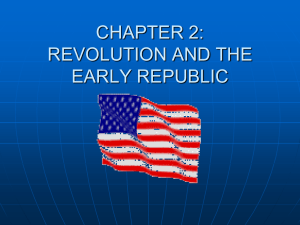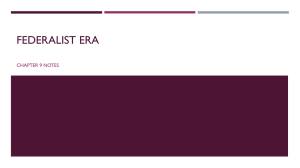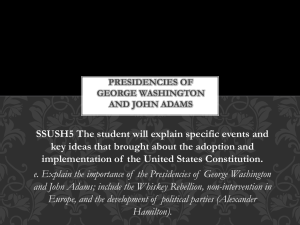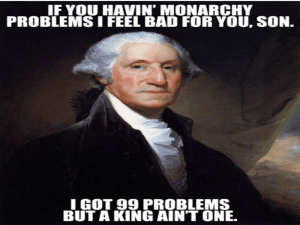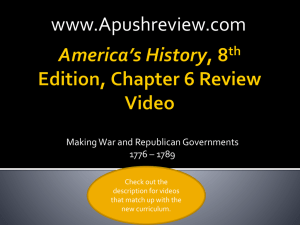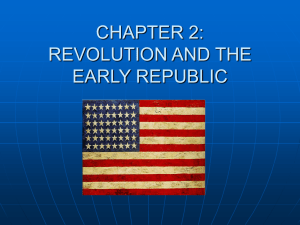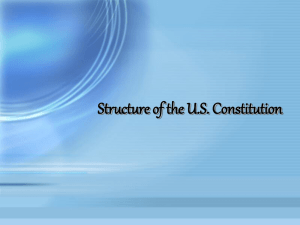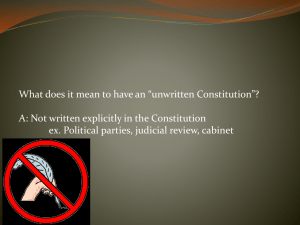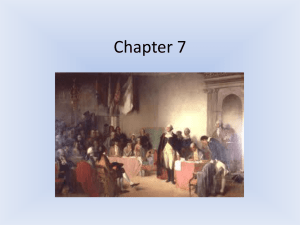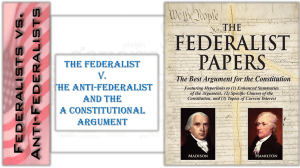SSUSH5-16: Explain how weaknesses in the Articles
advertisement
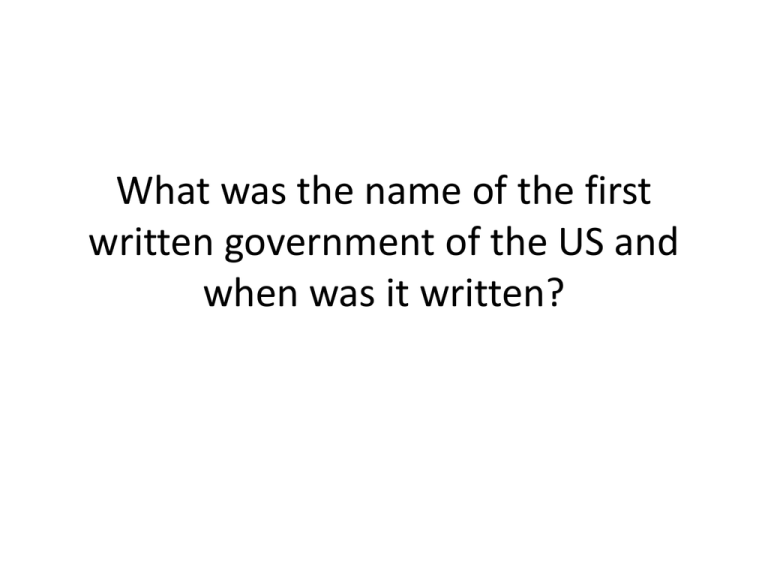
What was the name of the first written government of the US and when was it written? The Articles of Confederation was the first government of the United States, written by John Dickinson and adopted by the Second Continental Congress in 1777. The AoC was ratified in March of 1781. The AoC gave the one house government it created, the power to make war, make peace and sign treaties. What were the strengths and successes of the Articles of Confederation? The congress under the Articles did accomplish several important things: they won the Revolutionary War , they helped keep Washington’s army fighting and they negotiated favorable terms in the Treaty of Paris 1783. Why were the Articles of Confederation written the way they were? The writers of the AoC intended for this to be a weak government so that most of the power would be in the hands of the states Describe the weaknesses of the Articles of Confederation The Articles of Confederationdid not have the power to collect taxes, regulate the economy or any type of commerce, nor did they have any executive power to enforce its own laws, there was no national court system to settle disputes and there were 13 separate states that lacked national unity. Also the AoC established a onehouse government – a Congress where each state had only one vote and 9 out of the 13 was the required vote to pass laws. To amend (change) the articles, a unanimous vote was required. Who was Daniel Shays? Daniel Shays was a Massachusetts farmer who had fought in the Revolutionary War. He had much debt due to his time spent serving his country and not tending to his farm and now faced debtors prison. He believed he should not be taxed so heavily because he was in the army. How did Daniel Shays start a rebellion and what was it about? Shays convinced others to join him in trying to close down the courts in Massachusetts so they could not put them in jail. In September 1786, Shays led 1200 men to an arsenal in Springfield, MA to try and get arms. State officials called out the militia. How did the government react to Daniel Shays Rebellion? Panic spread through the nation’s leaders. If the states were unable to keep these types of situations out of control, it could be dangerous. Leaders felt this event demonstrated the need for a strong national government that could help keep order. How did the Constitutional ratification process bring about political divisions in America? When it came time to approve the Constitution, the AntiFederalists and Federalists had opposing ideas about what powers the federal government should have versus what powers the state governments should have Who were the Federalists and Anti-Federalists? The supporters of the Constitution, who claimed the name "Federalists," were arguing against a loosely organized group known as "Anti-federalists" who wanted the states’ goverments to have most of the power. What was the Anti-Federalist argument against the Constitution? The Anti-federalists denounced the Constitution as a radically centralizing document that would destroy American liberty and betray the principles of the Revolution. What was the argument of the Federalists in support of the Constitution? The Federalists urged that the nation's problems were directly linked to the frail, inadequate Confederation and that nothing short of the Constitution would enable the American people to preserve their liberty and independence, the fruits of the Revolution. Who were some of the prominent Federalists and what advantages did they have in the debate over the Constitution? The Federalists--led by Alexander Hamilton, James Madison, John Jay, John Marshall, James Wilson, John Dickinson, and Roger Sherman--had several advantages. In a time of national political crisis, they offered a clear prescription for the nation's ills; they were well organized and well financed; and they were used to thinking in national terms and to working with politicians from other states. They also had the support of the only two truly national political figures, George Washington and Benjamin Franklin. Who were some of the prominent Anti-Federalists and what advantages did they have in the debate over the Constitution? The Anti-federalists--led by Patrick Henry, George Mason, Richard Henry Lee, James Monroe, John Hancock, Samuel Adams, Elbridge Gerry, George Clinton, Willie Jones, and Melancton Smith--counted among their advantages the support of most state politicians and the American people's distrust of strong central government. Their most potent argument against the Constitution was that it lacked a bill of rights. How was the debate over the Constitution carried out? The lively newspaper and pamphlet war over the Constitution was a key element of the ratification controversy. Federalists and Anti-federalists published hundreds of essays praising or denouncing the document. What role did Alexander Hamilton, James Madison and John Jay play in this newspaper war? The wrote a series of 85 essays known as The Federalist , in support of the principles of the Constitution that were instrumental in winning support for ratification. What finally persuaded the Anti-Federalists to accept the Constitution and ratify it? The Federalists came up with a BILL OF RIGHTS – 10 amendments to the US Constitution that protected individual liberties, written by James Madison . The Constitution was ratified (approved), but the debate over what it means continues even today. How is the Constitution structured? It is broken into articles. Each article defines the power of a particular branch of the government – Legislative, Executive and Judicial – and the limits of the power of each of those, plus the Amendments. What was the Great Compromise? The Great Compromise was an agreement made among the delegates to the Constitutional Convention that the American government would have two houses in Congress: the Senate where each state has two Senators, and the House of Representatives where each state has a number of Representatives based on population. How did the Great Compromise help with the ratification of the Constitution? The Great Compromise ended one of the most serious disagreements among the new states. Small states felt that all states were equal in stature and that if Congressional representation were based upon population, they would be outvoted on everything. Large states felt that populations should determine how many representatives a state should have, because they were afraid that they would be outvoted by the small states. This disagreement was preventing the Constitution from being adopted. In order to move forward on the Constitution, the states compromised and made Congress as a bicameral legislative body. Explain how the men who attended the Constitutional Convention felt about slavery. The enslavement of blacks in America was of great concern to the men at the convention. Some genuinely felt that the black man was as much "man" as the white man. But this was a minority view. Southern delegates had one thing in mind when it came to slavery: to keep it going to prop up the Southern economy. Indeed, many of the largest slave holders in the United States were at the Convention. Most Northern delegates did not like slavery, but that does not mean they cared for blacks either. Many felt that the larger the black populations in the South grew, the larger the threat that that population would revolt against their masters and march north to exact revenge on the people who bought the goods they had been driven to tend. How did the delegates compromise over the issue of slavery and representation in Congress? One important concern about slaves, was if and how should they be counted for representation in Congress. The South wanted their slaves counted as whole persons, but that would never happen. James Wilson wanted to get the issue out of the way quickly, and asked the Convention to adopt the same standard as that in the Articles: slaves would count as three-fifths persons. This became known as the three-fifths compromise. How did the Constitution deal with the problem of the slave trade? The states of the deep south wanted to continue importing slaves; the North and the middle south was opposed. As the Convention progressed, though, it became clear to the South and her allies that some compromise would be needed. In exchange for a prohibition on export taxes, the South agreed to allowing the slave trade to continue for just 20 more years, and for imported slaves to be taxable. As a side note, the very day that the slave trade could constitutionally be prohibited, it was: on January 1, 1808. What does the Bill of Rights say? The Bill of Rights gives individuals the right to freedom of religion; free speech; freedom of the press and political activity; the right to bear arms against violence and government intrusion; the right to a fair and speedy trial. These rights are not denied to anyone, according to this collection of the first 10 amendments to the U.S. Constitution, people have these rights and privileges. The federal government cannot stand in the way of any of these rights. Who was the first President of the US? Washington took office as the First President of the United States. He and Congress had to create an entirely new government. Many of his early decisions have shaped the course of America’s history. How did Washington shape the Judicial Branch of the Government? First Washington and Congress created a judicial system with the Supreme Court as its head through the Judiciary Act of 1789. How did Washington shape the Executive Branch of the government Next he built an executive branch to help him make policies and carry out the laws. When Washington took office the executive branch was only the President and Vice President. Washington created three executive departments, The Department of State to deal with foreign affairs, the Department of War to handle military matters and the Department of the Treasury to handle financial matters. These departments became known as the Cabinet. How did Washington’s first cabinet lead to the development of political parties in the US? Immediately, argument broke out as to how to best run the country. Divisions sprang up between Thomas Jefferson and Alexander Hamilton. Even though Washington tried to remain above this, the split in his cabinet led to the formation of political parties in America. The key issue at the center of the argument was the power and size of the Federal government in relation to state governments. Those who wanted a strong federal government were called The Federalists (Hamilton, Washington, Adams) and those who favored strong state governments called themselves Republicans (Jefferson, Madison, Monroe). What was the Whiskey Rebellion of 1794? Congress had passed an import tax on goods produced in Europe. This tax meant to encourage American production and brought in a lot of revenue. Hamilton, Secretary of the Treasury wanted more revenue and encouraged an excise tax – a tax on the manufacture and sale of a product – on the manufacture of whiskey. Whiskey distilled from corn was the major source of cash for frontier farmers. The western Pennsylvania farmers rebelled in 1794 – this became known as the Whiskey Rebellion. What was important about the Whiskey Rebellion? Hamilton sent in 15,000 militiamen to put down the rebellion. This was an important show of force for the federal government to prove it could enforce the law. The Whiskey Rebellion was a milestone in the consolidation of federal power in domestic affairs. What problems did the early Republic have in international affairs? Another problem during Washington’s presidency carried over into the next presidency of John Adams and had to do with international affairs. The French had come to the aid of the colonists in the Revolutionary War. The French and the United States had signed an alliance (treaty) in 1778. When Revolution broke out in France the French wanted the help of the Americans. Republicans under Jefferson supported this idea. The Federalists under Washington/Hamilton/Adams were opposed What did Washington do on April 22, 1793 regarding this issue? Washington issued a declaration of neutrality saying that America would not get involved. How did Jefferson respond? Jefferson continued to support the French and resigned from Washington’s cabinet in 1793. What did Washington day in his Farewell Address? Washington decided he didn’t want to run for president for a third term. In a Farewell Address to the nation he urged the U.S. to “steer clear of permanent alliances with other nations”, to “not form political parties” and to remember the union of the states was of the utmost importance. Who became President after Washington? In the election of 1796, John Adams, a Federalist and Thomas Jefferson, a Democratic-Republican ran against each other. Adams won, but due to election procedures at the time, Jefferson became his Vice President even though he was of a different political party. Northern states mostly supported Adams, southern states supported Jefferson. What problems did Adams deal with as President? Adams faced the continuing pressure from the European war. The French government was angry the Americans had signed Jay’s Treaty with Great Britain, which they saw as favoring Britain over them. The French began to seize American ships bound for Britain. Adams sent a three man delegation to France to work this out. When they arrived, the French diplomats who were to meet with them demanded a $250.000 bribe to see the Foreign Minister Talleyrand. This event became known as the XYZ Affair and it provoked a strong wave of anti-French feeling in America. What was a major accomplishment under Adams? Congress authorized the building of a navy and an army. What made Adams lose popularity and his bid to be reelected in 1800? Anti French feelings continued. Federalists believed that French spies were everywhere, plotting to overthrow the American government and convinced Adams to pass the Alien and Sedition Acts. These laws made a longer waiting period for immigrants to become citizens, from 5 to 14 years. They also said the President could deport or jail and alien considered undesirable and fines and jail terms were imposed on people who spoke out against the government. These acts proved to be the downfall of Adams.

